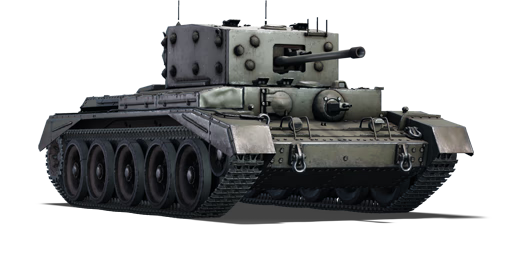



The Cromwell I (or just Cromwell I) was a British WWII-era medium tank named after 17th century military leader Oliver Cromwell. The tank was heavily influenced by the previous Crusader tank and the demand for a medium velocity dual-purpose gun by the Ministry of Defence. Initially, three different prototypes were named Cromwell. The initial A24 Cromwell I prototype made by Nuffield later crystallized into the A24 "Cavalier" cruiser tank, of which about 500 were made, but the performance proved unsatisfactory. The second prototype was the A27L Cromwell II made by English Electric and later Leyland. Out of this prototype, the "Centaur" was developed. Centaur was equipped with vintage WWI Liberty engine and Merrit-Brown gearbox taken over from Churchill infantry tank. The last prototype bearing the name Cromwell was the A27M Cromwell III, which then became the only tank bearing the name into serial production. The A27M used the Rolls-Royce Meteor engine but was otherwise similar to the Centaur, although due to the engine it had no issues with cooling and reliability. All the Centaur hulls were reengined and taken into service as Cromwells. The tank first saw action after the Normandy landings in June 1944. The usage of higher calibre guns then led to development of the Comet, Charioteer, and Challenger cruiser tanks, based on the Cromwell. After the war, Cromwell was also used by many other countries such as Czechoslovakia, Israel, and Greece. The British army also used Cromwells in the Korean War, where a few were captured by the North Korean forces.
The Cromwell was introduced along with the initial British ground tree in Update 1.55 "Royal Armour". The Cromwell Mk I uses the 6-pdr, which provides higher penetration than the 75 mm on the Mk V. It is also slightly faster and more manoeuvrable, thanks to the addition of an engine governor on the Mk V that lowered its maximum output. However, these advantages are offset by the higher BR which means the Cromwell will be facing some tanks that are well-matched in terms of speed, like the T-34, and some tanks that are largely invulnerable, like the KV-1E. The Cromwell has adequate armour for a medium tank and a reasonably powerful gun.
| Ammunition | Type | Armor penetration (mm) at a distance: | |||||
|---|---|---|---|---|---|---|---|
| 10 m | 100 m | 500 m | 1000 m | 1500 m | 2000 m | ||
| AP | 101 | 97 | 82 | 66 | 53 | 43 | |
| HE | 9 | 9 | 9 | 9 | 9 | 9 | |
| AP | 108 | 104 | 87 | 70 | 57 | 46 | |
| APC | 110 | 106 | 89 | 72 | 59 | 48 | |
| APCBC | 122 | 118 | 101 | 84 | 70 | 58 | |
| Belt | Belt filling | Armor penetration (mm) at a distance: | |||||
|---|---|---|---|---|---|---|---|
| 10 m | 100 m | 500 m | 1000 m | 1500 m | 2000 m | ||
| AP-I/AP-I/AP-T | 9 | 8 | 6 | 3 | 0 | 0 | |












Mobility | |
|---|---|
Protection |
|---|
Firepower | |
|---|---|